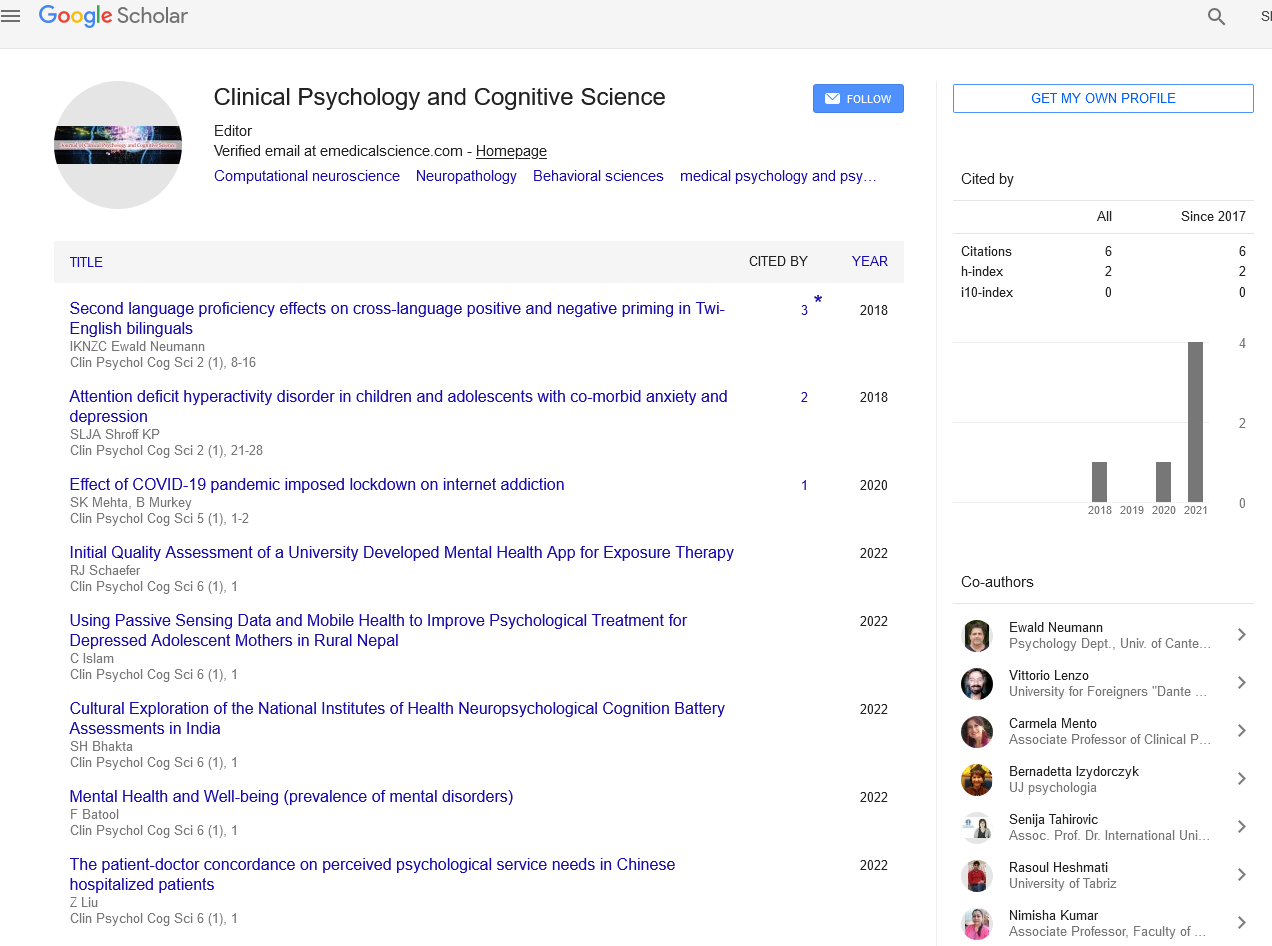The role of dreams in the human mind
Received: 08-Nov-2021 Accepted Date: Nov 22, 2021; Published: 29-Nov-2021
Citation: Zyphur M. The role of dreams in the human mind. Clin Psychol Cog Sci 2021;5(3):9.
This open-access article is distributed under the terms of the Creative Commons Attribution Non-Commercial License (CC BY-NC) (http://creativecommons.org/licenses/by-nc/4.0/), which permits reuse, distribution and reproduction of the article, provided that the original work is properly cited and the reuse is restricted to noncommercial purposes. For commercial reuse, contact reprints@pulsus.com
Abstract
Freud proposed that dreams, especially the meaningful content of dreams, were related to mental function, but the rarely misunderstood nature of dreams is very proposing to empirically support or forge this claim. He made it a problem. The inability to study the effects of dreams on mental function has led many researchers to dream as a result of random neural activity (Example: activated synthetic hypothesis by Hobson and Mc Carley). Given that the assumptions about the random nature of dreams are actually correct, it is difficult to propose a theory of how the phenomenology of dream states plays a functional role and can be better understood through evolutionary analysis. However, recent studies discussed take into account the underlying physiological mechanisms of sleep and dreams, the content of dreams, and the environmental conditions of choice, and the nature of dreams as a state of consciousness that remains in between. Evolution of human species suggests that selection is present throughout. This suggests that the dream state was chosen as an adjustment to improve overall fitness. The main theory dealing with dream adaptability is to deal with it by studying various threat scenarios, using the concept of virtual threats, which is defined as a dream state in which the threat situation is virtually constructed. Explain that better equipment may be possible Real-world threats. While this theory provides a plausible evolutionary explanation of dreams, the purpose of this article is to comment on other aspects of dream enhancement and the broader impact of dreams on the evolution of higher mental functions.
Description
Freud proposed that dreams, especially the meaningful content of dreams, were related to mental function, but the rarely misunderstood nature of dreams is very proposing to empirically support or forge this claim. He made it a problem. The inability to study the effects of dreams on mental function has led many researchers to dream as a result of random neural activity (Example: activated synthetic hypothesis by Hobson and Mc Carley). Given that the assumptions about the random nature of dreams are actually correct, it is difficult to propose a theory of how the phenomenology of dream states plays a functional role and can be better understood through evolutionary analysis. However, recent studies discussed take into account the underlying physiological mechanisms of sleep and dreams, the content of dreams, and the environmental conditions of choice, and the nature of dreams as a state of consciousness that remains in between. Evolution of human species suggests that selection is present throughout. This suggests that the dream state was chosen as an adjustment to improve overall fitness. The main theory dealing with dream adaptability is to deal with it by studying various threat scenarios, using the concept of virtual threats, which is defined as a dream state in which the threat situation is virtually constructed. Explain that better equipment may be possible Real-world threats. While this theory provides a plausible evolutionary explanation of dreams, the purpose of this article is to comment on other aspects of dream enhancement and the broader impact of dreams on the evolution of higher mental functions.
The Subjective Nature of Dreams
The nature of the dream state is so subjective and truly personal experience that the scientific analysis of dreams is somewhat exorbitant. Dreams often contain meaningless and reasonably interpreted material, and characterizing dreams from an objective point of view can be a confusing task. Although we all dream, there is incredible variation in subjective dream experiences. Some people misunderstand that they have few dreams and never dream, while others experience vibrant dreams with rich visual images and emotional content. There is also the storylines that make up people's dreams follow tight stories, and scene-to-scene transitions can be relatively smooth, but dreams are viewed as illogical and arbitrary associations that lack a coherent flow. Some people have complete control over their dreams and consciously control what appear to be random events typical of dreams to the will to wake up. Given the diversity of dream dynamics, it is surprising that there are different views on the nature of dreams, as researchers' views on dreams may be directly related to their own subjective dream experiences.
Despite this subjective nature of dreams, the evolutionary analysis of dreams should not be ignored and should be seen outside the scope of scientific research. Since the cognitive revolution, psychology and other disciplines have made great strides in the development and implementation of methods designed to uncover the truth about the mental processes underlying our subjective experience. For example, tools in cognitive neuroscience have made it possible for data from neuroimaging to inform our cognitive theory. It is not reasonable to believe that these methods can one day establish a correlation between a particular pattern of brain activity and the corresponding dream content, so that current technology can accurately predict information from subjective experience. For example, neuroimaging evidence can provide information for switching low-level sensory experiences. With this in mind, we work on dream research in a scientific way by building a theory based on scientifically collected data, rather than being biased towards our own subjective dream experience is important.





